It may not be too common to hear about bio-based inks for printing, based from the recent years there were development and innovations with regards to this matter and most were considered good news. Through those innovations we've greatly improved and change the way we print, but the output still remains the same, even paper materials and other medias used for printing are still being consumed. How are those changes can be beneficial for the environment? Unless the chemicals particularly the inks and toners were improved, wherein a breakthrough to form environment-friendly pigments and toners or dyes had been developed. According to some University researchers, a new form of color production has been developed. It was known as "physical color" named by the scientific community. Amazingly, this breakthrough allows the production of colour images without the need for inks, dyes or such chemicals. The Electrical Engineering and Computer Science Professor, also the Head of the research lab, Jay Guo, explained: "Instead of coating a material with ink or chemicals, lab uses precisely inscribed grooves to yield an observable color. Rather than using these chemicals, you could basically emboss the structure — a very ‘green’ print technology.” Aside from the great fact that all printed products made through this innovation are all environment friendly, the problem of fading prints was also eliminated due to the advance coloring techniques applied. The process which is also quite similar to traditional color production was called " Structural Color". Traditionally, colors are produced when molecules absorb light, but with structural color, nano-cavities trap light at specific wavelengths depending on the depths of cavities. The structure of cavities allows them to display colors, thus in a way it can be called a physical effect since it is the structure that is being altered rather using the molecules to create a chemical effect from which colors can possibly be produced. This innovation is certainly a discovery worth to improve, the progress may lead to far more better technology that can be applied in several scientific fields. It seems that those eco-friendly toner cartridges and ink cartridges aren't all alone when it comes to promoting greener printing practices. I hope that this technology will soon be a reachable as well as an affordable printer consumables for the masses. For the full details about the research you may refer on this link.
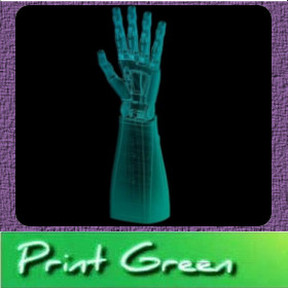 Designing a robotic arm is an idea that is quite easy to think of yet hard to implement. For most geeks who can definitely create one anytime they wanted given the materials they need, developing a robotic arm is quite a breeze. But for someone who doesn't have much experience and idea about it and who only got an inspiration to create one, that is more noble and admiring. From a Science Fair, a 17-year old geek, Easton LaChapelle was inspired by a competitor who wore a prosthetic arm that unfortunately it needs to be replace to complement her body as she grew up. He used it as an inspiration and took his self-made robotic arm to a much higher level. From a robotic arm made of LEGO materials, his goal was to develop a fully functional prosthetic arm for a very affordable value. LaChapelle was successful to create a prosthetic arm with the use of LEGO materials, fishing wire and surgical tubing. With the help of 3D printing technology, he made it into success offsetting the expensive costs of having a prosthetic arm. A Teensy Arduino micro-controller was used along with an amplifier circuits and Bluetooth receivers. The basic movements that the prosthetic arm can execute reacts according to - muscle flexing and blinking the eyes, it's also equipped with an EEG headset that measures the brainwaves to control the arm movements. Through the use of a 3D printer - PrintBot, a few parts were created except for the gears, motors and screws, which brought a total of $250 overall cost. Now your dream to have an affordable prosthetic arm is now reachable with the creation of LaChapelle's robotic prosthetic arm. Heineken recognized his creation and asked LaChapelle to produce about 5,000 pieces of his robotic arm for their bars to serve beers to their customers. Well it seems that after utilizing the application of 3D printing technology to produce human organs through stem cell, creating prostheses with the help of 3D printers are now getting into the hype. But let's assume that these technology will be more useful as it is not only for those who will benefit using it, but also for the environment. Like the printing industry lately, an agreement to green their business particularly the printer manufacturing business was supported by the largest names in the printing industry. Complying to the agreement leads to manufacturing green printer consumables such as eco-friendly toner cartridges and ink cartridges, as well as going green in their production of equipments. While the components being used and produce in 3D printing technology may possibly harm our environment, they should at least find a better way to create useful necessities and equipments without making any negative impacts that would affect the environment.
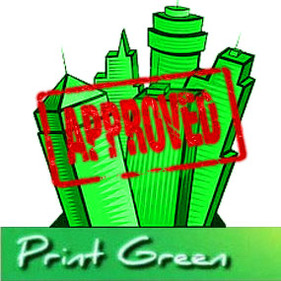 Going green has no limit or no extent, small communities or big companies, they are all turning into a greener environment and practices. Several industries nowadays have already switched to a better environmental friendly manufacturing and services. Since there are several individuals and small organizations that started it all, why not those big names in the industry must not follow. Supporting the voluntary agreement by the biggest printer manufacturers in the printing industry, the European Commission has accepted to GO GREEN in their industry. They favored the agreement to set a target on greatly reducing the EU industry's carbon footprint emission in terms of printing and copying. Promoting proper recycling of reusable devices and printer consumables such as ink and toner cartridges, as well as improving energy efficiency of such printing devices, ink, toner and paper usage/consumption. The said major manufacturers complied to commit on promoting and bolster to encourage the utilization of "Duplex" (double-sided) printing as well as "N-up" (several pages per sheet) printing in order to cut down the use of paper materials. The full list of printer manufacturers that will sign up with the voluntary agreement are as follows:Brother Konica Minolta Okidata Toshiba
Canon Kyocera Panasonic Xerox
Dell Mita Ricoh
Epson Europe Lexmark Samsung
Hewlett-Packard Murata Machinery Sharp The Commission said: "The voluntary agreement has undergone a thorough impact assessment and we have concluded that it could be considered equivalent to binding regulations adopted under the EU’s 2009 Ecodesign Directive."While William Dazy, the Chairman of EuroVAprint, said : “We welcome the Commission’s endorsement of our voluntary agreement in the context of the Ecodesign Directive,
We are looking forward to further cooperation with the EU institutions in this area.”
The listed big names in the printing industry that participated in the said agreement have set up the "EuroVAPrint Organization", this will check and evaluate each companies effort towards a greener industry. Thus, we may expect a great improvement in their operations and productions in terms of being environmentally conscious. We should give credit to those printer manufacturers that had been accepting printer cartridges recycling for such a long time even before this agreement came out. Eco-friendly toner cartridges and ink cartridges, as well as recycled printer paper materials will certainly help on reducing carbon footprint and negative impacts that the print industry have brought from the past years.
Have you ever sold something very important that you've been keeping for years, just to buy an expensive gift for your special someone? Well I commend you for doing such a thing, just like Jonathan Brand, a long time owner of a late 60's Ford Mustang car model which he sold just to afford buying an engagement ring for his future better half. The car was actually so much worthy for him that he and his father had restored it for so many years just to keep its beauty. But on the day that he decided to settle down with the women of his life, he painstakingly let go of his treasure over a ring. Then realizing the agony of loosing his Mustang, he became so determined to recreate it, with the use of inkjet papers and printouts.
As it turn out, after loosing such a memorable keepsake, he then transformed as an artist and recreate his Ford Mustang through his memories with it. Of course Brand created a CAD model of his car on a computer and from that structure he started assembling each parts with the use of papers and glue. The replica was called "One Piece At A Time". If you're familiar with Johnny Cash, he also had a song entitled One Piece at a Time, thus naming his remodeled car with that title is actually an honor to the said song. Surprisingly the song was about an assembly line worker who cleverly built a Cadillac from stolen parts, one piece at a time.
Brand explained his fragile creation :
“The details of the car are based more on my memory and a few photographs, I no longer have access to the original car and chose not to use a surrogate to measure and get all the details correct. I like when things are slightly off, in the wrong place or missing, just like my memories of the original.”
Using the CAD model he created, three-dimensional drawings were printed out using a large scale inkjet printer, then one piece at a time he constructed remodeling his Mustang with paper pieces and some glue. The colors from the printed materials were actually inks, thus it makes a really costly project. It was more of like a jigsaw puzzle where his 3D drawings are the pieces which he fold and glued until he came out with this awesome Ford Mustang fragile replica. I wonder if he used recycled paper materials or old printouts, but I hardly doubt, since his cutouts are in printed in full color. But let's supposed he equipped the printer with bio-based ink cartridges or eco-friendly toner cartridges to reduce harmful effects once his jaw dropping creation worn-out and reach its disposal limit.
Have you seen a printer that instead of making printouts, toasted breads are ejecting from it? It's not very common for us to see new and peculiar equipments, sometimes there are few concepts that are just too good to be true. Even a bread toaster isn't something too exciting to see, but knowing that it features a naive design and an unusual concept, then that makes you curious. An unusual application of printer concept has been applied to one of our easy breakfast meal helper, a bread toaster that mimics an inkjet printer. Designed by Othmar Muhlebach and was named Printer Toaster, with the goal to renovate a somehow usual tool into something that kicks a new way of creating a hot and fresh toasted bread. Consider it as the modernize way of toasting wherein you just have to wait for the bread to drop on the lower tray, nicely done, hot and ready. The design won second prize at the Berner Design Awards. If you're familiar on how an inkjet printer or a fax machine shoots a paper sheet, then watching the Printer Toaster will surely amaze you the same way. Now if you still can't get enough, how about while waiting for some of the breads to get toasted from the Printer Toaster, make some or rather burn some nice images onto your bread. How is it possible? Meet the Zuse Toaster, it can burn an image with at least 12 x 12 pixel in size. The said printer can be re-programmed so users can create a random image printout in a loaf of bread. Literally put a smile on every bread you serve and have a fun breakfast with your family and friends. What I'm partly hoping is that, it would be better if this Printer Toaster can be equipped with real cartridges wherein instead of inks, users can put jams of different flavors as well as butter. Also, why not transformed a laser type printer to something like the Printer Toaster, it can probably toast your bread and create an image all at the same time. While we can't afford to buy either of the two unique printer, don't even try disassembling your personal printers just to have one. Instead practice green printing to cut down your printer expense and help save the environment as well, by using eco-friendly toner cartridges and ink cartridges on your printers.
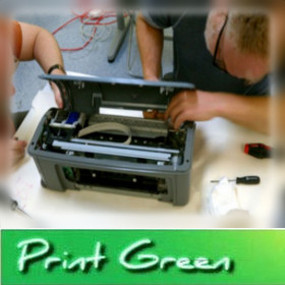 Photo Credit : Instructables BioPrinter Bioprinting as an emerging technology, has gone through a lot of innovations and development that lead to its specific goal of achieving to develop new human tissues and organs. Through hard works and research done on bioprinters, full organs were produced and used by many which create a huge shift on their life. If we will define it, Bioprinting or tissue engineering, is the process the produces organs via a printer that feeds biological materials. An inkjet printer is used as the machine, but instead of ink, cells are deposited on a surface layer by layer, thus an organ has been produced. 3D printer nowadays are being modified to produce the same output, however the success isn't that much. Leaning to his own ingenuity, Patrik, one of the genius member of Instructables, modified an HP inkjet printer, and to his success he was able to transform that abandoned machine into a working DIY Bioprinter. For the complete information about Patrik's DIY Bioprinter, you may refer on the link here. Hacking an old inkjet printer isn't something new to hear, but the fact that it was transformed into a bioprinter is an amazing reason to give credits to this man. Patrik and his team work with the inkjet printer by undressing it first, disassembling the components and covers, as well as reconstructing a new wire system for the paper handling mechanism. After checking if all the buttons are still working fine after all the alterations and modifications inside the printer, next thing they do is prepare the cartridges for a dissecting project. Since it's the printer uses inkjet technology, therefore the project requires inkjet cartridges, unless someone might take the challenge modifying a laser type printer, so there would be a bigger container such as a toner cartridge that can be filled with more biological materials. For printer users who practice green printing, consider opting for eco-friendly toner cartridges and ink cartridges for all your printing needs. They open the cartridges that will be used and tried to fill it with biological materials. Making sure that even though they'll be using new cartridges, they make sure that it's been free from clog and residues, neither no holes, by rinsing each cartridges with distilled or deionized water. Then running a few test print to see if the cartridges and the printer synchronously work together. With their first test print, the team printed arabinose over a half filter paper - placed on an agarose plate that lights up under UV light. To their success, they were able to print a BioCurious eyeball logo. Perhaps their project still needs some refining process to make it work as a fully functional BioPrinter.
LED lights are indeed environment friendly, aside from the fact that they are now commonly used to replace fluorescent light bulbs in order to cut down one's electricity bill as well as reducing negative impacts on the environment. These tiny little pieces of nature caring light emitting diodes are not just use for energy conservation but also for everyone's amusement. A starry starry night to imagine, a romantic glittering place to spend calmness and let yourself be amazed of the twinkling spectacle that LED lights can bring you. The Galleri ROM in Olso, Norway, hangs a hundred strings of floating LED lights that feature about 8,064 pieces of tiny luminous bulb gleaming inside the gallery. The exhibition was named Submergence, designed by Squidsoup, an international group of artists, researchers and designers (UK/NO/NZ) working with digital and interactive media experiences. The gallery will exhibit Submergence from January 17 till February 17, 2013. Inside the gallery, while enjoying the spectacle, passing through the lights triggers a reaction that detects any presence from the surrounding area, creating an audiovisual display that can range from tranquil to hectic. While being encapsulated by these thousand points of light, each bulb pulsates and in a synchronous pattern the light intensity increases, altering the perspective view of the guest passing through it — which tends to confuse the guests and let them lose track of where they are heading inside the dark gallery. As Inhabitat explained, "The piece morphs from darkness to a myriad of colors, sometimes slowly, and sometimes at an energetic frequency, causing further spatial confusion. The light installation transforms from hazy rain-like violet to gauzy orange, alarming red, and other colors that evoke a feeling of calm or anxiety" Each transition is accompanied by a soundtrack that varies depending on the light pattern that is being display, from totally dark to brilliant colors, slowly then gradually changing to rapid variation of color with accompanying energetic soundtrack that sometimes determine the visitors mood. Submergence was designed " to create a work that would evoke a virtual world through sound, light and space, controllable by each visitor." You see, these environment friendly little piece of technology doesn't end up with just a sole purpose, it can also be utilize to inspire and amuse people through art. There are thousands of innovative materials that can be transform into artwork pieces, it's just that no one haven't got the idea to do it. PrintGreen have already featured some designs that use printer cartridges, turning these eco-friendly toner cartridges into art exhibits and other inspiring art pieces.
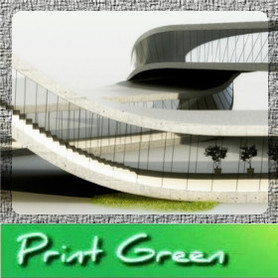 Since the emergence of 3D printing technology, various products created through the said technology were introduced in the market. Conventional manufacturing alone will not be enough to produce this new innovations, and without 3D printing, there are only small chances to be considered and it wouldn't suffice to produce what 3D printing can actually made in just a small span of time. Aside from the considerably small fraction of time that 3D printing takes in order to create an actual output. It can also be used to generate something that is made from eco-friendly materials. In addition to these unbelievable facts, there are researches who have been working on such plan to print an entire frame of a house in just a matter of day. It may sound absurd and unbelievable, but with Janjaap Ruijssenaars, principal of Universe Architecture based in Amsterdam, building the world's first 3D-printed house is something reachable. The concept includes printing out several pieces of 6x9 meters sized frame for the house using the D-Shape 3D printer, to assemble a Mobius strip-shaped house structure. The frame will be using sand and binder, which will be filled or coated with concrete and fiberclass to be able to create a sturdy, flexible and solid two-story building. Ruijssenaars explained the design's origin as, "It was a house in Ireland, the location on the coast is so beautiful that we want the design to reflect the nature." A landscape with an endless, no beginning neither no end design of a house, that's simply how someone would describe this incredible structure. A house that reflects the nature, quite interesting and also intriguing. Although it's called a house, it seems that this two-story structure is just too open literally to live there. But you can still furnish it with couch and seats that suits the concept and designed of the house. It was the collaboration of these two genius people, Janjaap Ruijssenaars and Rinus Roelofs, an artist and mathematician, with the intention to create a continuous movement through a residential space and out onto the surrounding landscape. The initial plan to build a house was actually to designed it for the biennial European architecture competition, and it is expected to be completed in 2014. Though it seems enjoyable to have a rest house like this, with the touch of technology and environment friendliness, this concept will soon become a hit. Since not everyone can't afford to have one of this, and that's given, you can instead purchase or utilize house products that features both the latest functionality and being environment friendly, like LED lights, or even eco-friendly toner cartridges and recycled papers for your printing needs.
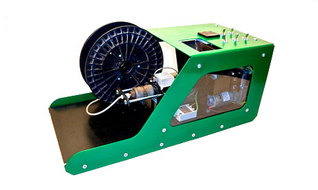 Photo Credit : Kickstarter It's been several months since 3D printing technology became available to the masses, more affordable, convenient, compact and improved versions have been developed for the consumers to utilize. The way consumer goods were fabricated was transform and became more customizable, enhanced and of course easy, but still the products sturdiness and quality remain. Although we can purchase a machine that can produce three-dimensional products and stuffs for us to either use personally or for whatever purpose we wanted, it's just a one time expense we're talking about here. Let's not forget the point that as 3D printer user, you should also consider the cost of maintaining the machine as well the supplies it requires to run. And that particular 3D printer consumable is the plastic filament, which is typically costly and yes a bit of hard to find. For those who are not aware of how much would it cost to buy a plastic filament for 3D printers, well it will cost about $50 or more to purchase a single spool of it. Fortunately, for those who find it a troublesome to replace their printer's filament, here is a great solution that will put an end to your problem. The Filabot, " a machine that allows anyone to make their own 3D printing substrate from old recyclables sitting in the bin." Invented by Tyler McNaney, a genius student from Vermont Technical College in Randolph, United States. Tyler's invention which was funded by Kickstarter, is a compact machine that can turn waste plastic material into a usable filament for 3D printing. Filabot, with its 12 x 12 x 24 dimension, can powerfully grind and melt, then eject the material out of its small recycling-plant-like housing. From an actual test, a single milk container and a detergent bottle can actually be enough to produce an 8 feet long plastic filament for your 3D printer. There's a coil heating element inside this terribly small machine, it varies the temperature to accommodate different types of plastic material. It's been said that the final model of Filabot will feature a tip that can be adjusted to the desired filament diameter. Now if you're wondering if it's out in the market, then McNaney is currently working on it, to produce a batch of Filabot machines to sustain the first wave of orders. For Kickstarter backers, you can get this machine for about $350. When will it be launch to the public, that's a question they can only answer so better check their website for updates. If you've got a lot of plastic waste in your business, then this machine is a business opportunity for you. Make those stream of plastic waste material turn into 3D printer filaments and sell it to the market, that sounds real money. You get a business, plus helping reduce environmental impacts, that's just too awesome. Recycled materials are less cheaper but still sturdy, just like those eco-friendly toner cartridges and ink cartridges, alternatively reliable for your printing needs.
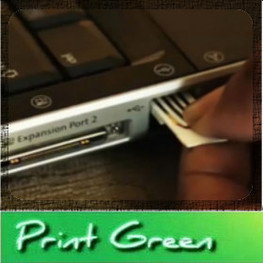 Technology, aside from the fact that it comes with some environmental impacts, it also brought some innovations that led to a few advantages. One of which is the traditional way of using paper materials to keep a copy of files or documents, we then changed it and adapt to the industry advancement through utilizing mobile devices like smartphones and tablets to store our files and documents. Thus, we reduce the amount of paper used to store information and files. Though having said that, it doesn't mean we completely eliminate the use and purpose of paper materials in the digital world. In fact, intelliPaper, a business company that provides products in the data sharing consumer industry, has found a brilliant and extremely surprising way of transforming a tiny piece of paper into a fully functional storage device, specifically the one we called USB drives. One main reason they came up with this invention is cut down the huge waves of e-waste which as we all know, heading to the landfills and contaminates the surrounding environment. If you're wondering how this clever piece of USB technology was developed then here's how, intelliPaper embedded a silicon chip between the layers of paper, laminate those layers, then printed conductive USB traces onto the paper which connect to the main chip. Surprisingly and merely unbelievable, the finished paper USB drive can be embedded into any type of paper product. Although there are micro USB drives like the ones from Verbatim, Buffalo, SanDisk and many more, one thing you should know is that, they're are typically coated of plastic. When the product reached the end of its useful life, just pull out the electronic strip inside and then you can just tossed the paper material right into the bin. Using this device, one thing is for sure, you maximize the usefulness of the paper material you utilize from using it. We've been trying to come up with more ways to reduce our paper usage, and this invention will definitely top the list. You can also practice paper less printing to save on your regular printing expense, or try using eco-friendly toner cartridges and ink cartridges for your printer to save more.
|






 RSS Feed
RSS Feed